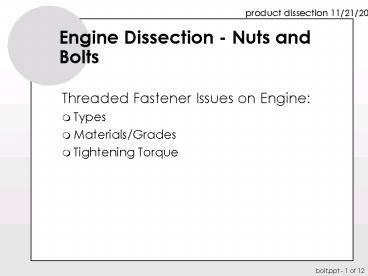Engine Dissection Nuts and Bolts - PowerPoint PPT Presentation
1 / 12
Title:
Engine Dissection Nuts and Bolts
Description:
400,000 other fasteners costing about $250,000. 30,000 squeeze ... Kalpakjian, S. Manufacturing Engineering and Technology, 2nd Edition, Addison Wesley, 1992. ... – PowerPoint PPT presentation
Number of Views:369
Avg rating:3.0/5.0
Title: Engine Dissection Nuts and Bolts
1
Engine Dissection - Nuts and Bolts
- Threaded Fastener Issues on Engine
- Types
- Materials/Grades
- Tightening Torque
2
Threaded Fasteners
- Did you know that?
- the Boeing 747 uses about 2.5 million fasteners
- 70,000 titanium costing 150,000
- 400,000 other fasteners costing about 250,000
- 30,000 squeeze rivets, 50cents each installed
- In certain applications (such as an engine head),
you should tighten the bolt as much as possible,
if it does not fail by twisting during
tightening, there is a very good possibility that
the bolt will never fail
3
Why are fasteners used?
- Advantages
- Removable
- Easy to install
- Wide variety of standard parts
- Disadvantages
- loosening
- failure
- cost
4
Types
- Machine screws
- Wood screws
- Tapping screws
5
Standard Thread Systems
- Unified or American
ACME - SI (ISO)
- Pipe
Whitworth (UK)
6
Typical Designation
- 1/2 - 13 UNC - 2A
Terminology of screw threads Sharp vee threads
shown for clarity the crests and roots
are actually flattened or rounded during the
forming operation.
external thread (B means internal)
Class of fit (1 is loosest tolerance, 3 is
tightest)
Thread Series UNC (Unified Coarse) UNF (Unified
Fine)
Pitch (threads/inch)
Nominal Diameter (also shown as decimal or screw
)
7
Bolt Grades
- Grade indicates the tensile strength of the bolt
- Determined by bolt material and heat treating
8
Materials
- Lets look at the example of engine head bolts
- The head is alumimum, so why are the head bolts
made of steel ? - In what cases might you want to use an aluminum
bolt?
9
Tightening Torque
- It is typical on engines for bolts to have a
specified tightening torque. Why? - It results in a quantified preload on the bolts
- Insures that parts never separate
- Maintains friction (no sliding to shear forces)
- Insures even distribution of loading
- prevent warpage of mating parts
- uniform pressure distribution over seal or
gasket - Prevents bolt from loosening
- Reduces fatique effects
10
Bolt Manufacturing Processes
- Forging (upsetting)
- Rolling
a)
b)
Thread-rolling processes a) reciprocating flat
dies and b) two-roller dies. Threaded fasteners,
such as bolts, are made economically by these
processes at high rates of production
11
Manufacturing Processes - continued
- Turning on screw machines
(a) Differences in the diameters of machined and
rolled threads. (b) Grain flow in machined and
rolled threads. Unlike machining, which cuts
through the grains of the metal, rolled threads
have improved strength because of cold working
and favorable grain flow.
12
References
- Kalpakjian, S. Manufacturing Engineering and
Technology, 2nd Edition, Addison Wesley, 1992. - Spotts, M.F., Design of Machine Elements.
Prentice-Hall, Inc., 1985. - Shigley, Joseph and Mitchell, Larry, Mechanical
Engineering Design. McGraw-HillBook Company,
1983.































